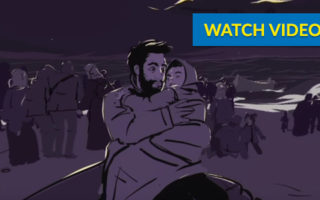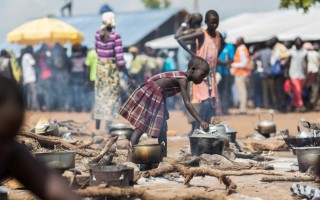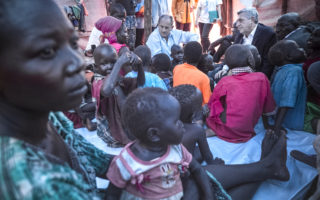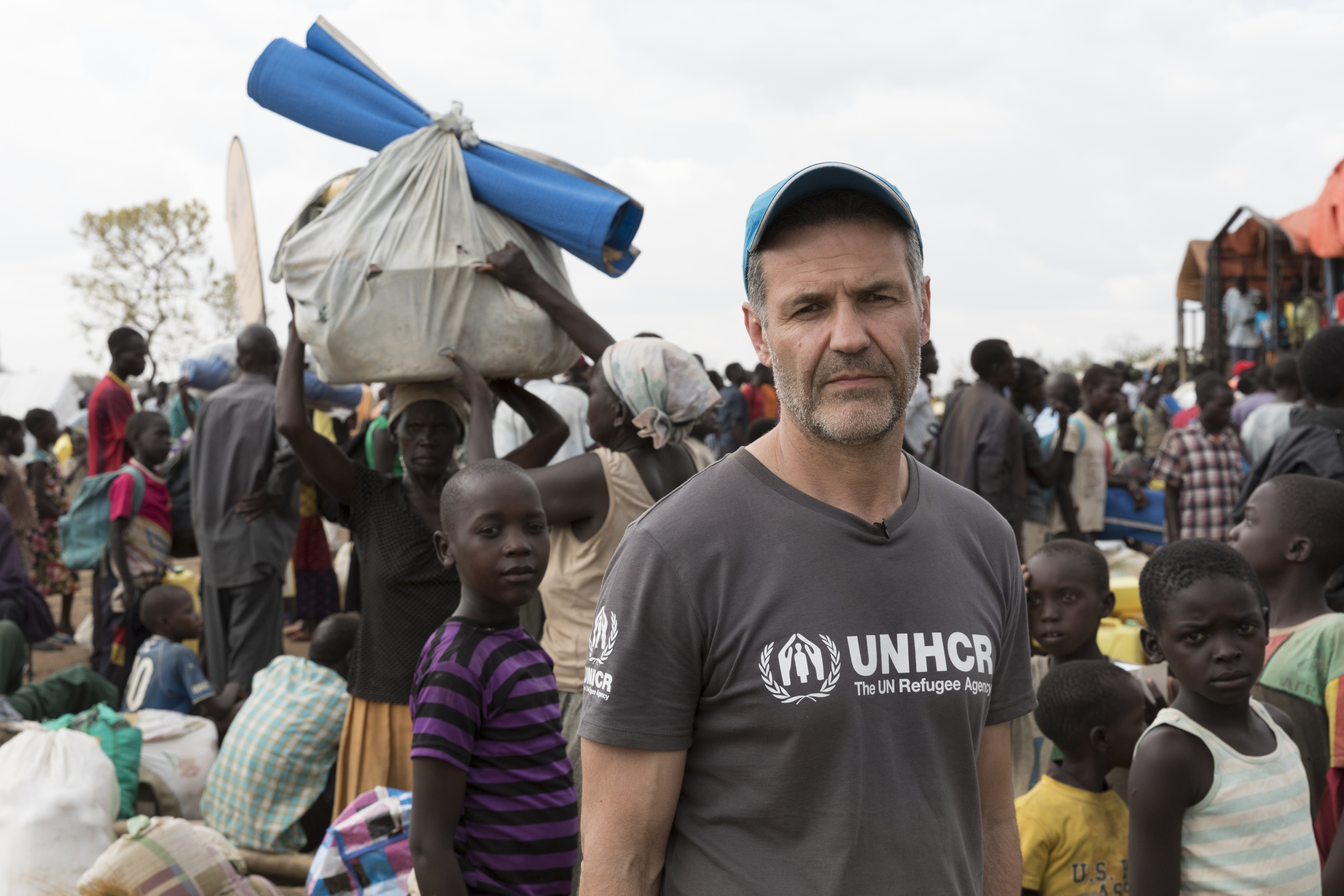
UNHCR Goodwill Ambassador Khaled Hosseini at the Reception Centre at Imvepi.
By Khaled Hosseini, award-winning author and UNHCR Goodwill Ambassador.
Looking over the shoulder of Gladys, a young South Sudanese refugee flicking through a frayed album of old family photos, my mind flashes back to my own younger self. In 1983 I was in high school. I was responsible for my grades, for keeping my old Dodge running and helping clean the room I shared with my brothers. My great aspiration was to see Springsteen live one day.
At 18, Gladys is a de facto mother to seven children. The war in South Sudan has forced her into looking after a brood of younger siblings and cousins. Gladys’ own proximity to childhood appears a forgotten fact in the family, most irreversibly by Gladys herself. It falls on her to make sure the children get their studies, despite the four-hour round trip from the Imvepi refugee settlement to the school.
Her days are consumed fetching water from a well, collecting firewood, making meals, cleaning inside the wooden pole and tarpaulin shelter that UNHCR, the UN Refugee Agency, provided for the young family when they first arrived here in northern Uganda in 2016. Gladys flips the pages of the album. I see families and homes that are no longer. Smiling faces from the past, a feast once laid out in a garden, a bygone birthday party, a graduation, picnics and weddings and children playing on porches. A photo of Gladys with her mother. Gladys’ mother too is gone.
We sit perched on the side of a bed on which Gladys never sleeps. At night, she tucks in four of the younger children here, the other three on a mattress at the foot of this bed. Gladys sleeps on uncovered earth between bed and mattress, on the hard ground between brothers, sisters and cousins.
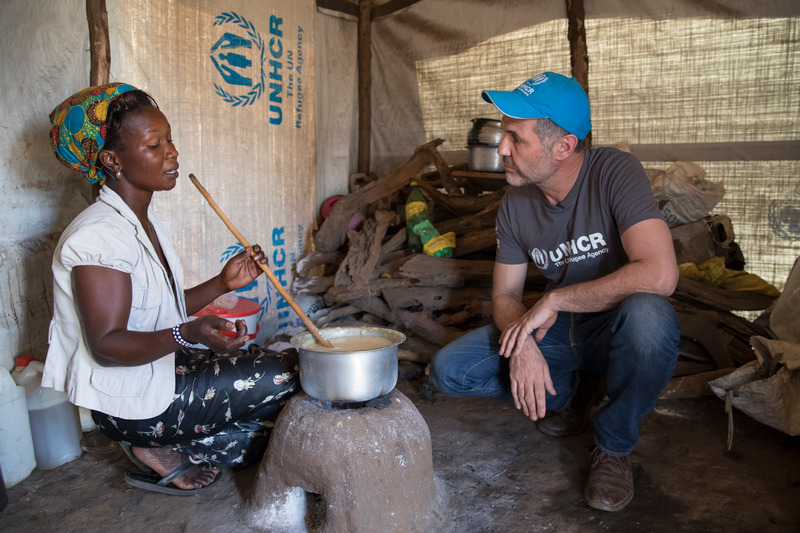
Khaled Hosseini meets South Sudanese refugee, Aisha, in Bidibidi refugee settlement. South Sudanese refugee Aisha is a single mother looking after 5 children in Bidibidi refugee settlement.
Gladys speaks with hushed poise as she turns over each album page, belying the fact that she has seen at her tender age the very worst of man. She tells me she was dragged from a bus that was set on fire, with women still screaming, still inside. She was forced to watch people she knew hacked to death before her, one by one. Gladys shrugs gently. She says she doesn’t understand why she was allowed to live. We get up to leave the shelter. Outside, when I kneel to put my shoes back on, she smiles. She had said when inviting me in that it wasn’t necessary, waving shyly at the modesty of her home.
Inside the shelter, everything points to human life derailed, everything a simulacrum of normalcy: the precious photo album, a few school books, a well-thumbed Bible, a crocheted blanket, a teddy bear. Looking around, I spot things I have come to know well from previous travels with UNHCR, the “core relief items,” kitchen set, jerry cans for water, a solar lamp under which the children do their homework at night, blankets, dry food rations, a hygiene kit of soap and sanitary pads. A starter pack for dignity. The basic blocks for building back a life. The shelter may be spare, but it is Gladys’ home, the place where she and the children sleep, eat, laugh, tell stories and secrets, squabble and make up. It is under its roof that they feel rooted and safe.
[Gladys] was forced to watch people she knew hacked to death before her, one by one. Gladys shrugs gently. She says she doesn’t understand why she was allowed to live.
Outside, before we say our goodbyes, I ask Gladys what her great aspiration is, remembering my own dreams of seeing The Boss in concert. Gladys says she hopes to find a job so that “I can take care of my brothers and sisters and make sure they have a good education in the future.” She laughs timidly. “My perfect job would be accounting.” I watch them exiting the buses, boys still in school uniforms, mothers, exhausted.
Back on the bumpy road out of Imvepi, heading for Adjumani on the other side of the White Nile, I can only marvel at Gladys and her resolve. At all the other Gladyses coming across the border daily. The staggering 75,000+ children who have fled South Sudan either unaccompanied or separated from their families. At every border point, reception centre or refugee settlement I visit here in Uganda, I find areas specially designated for them, the unaccompanied and separated children, the most vulnerable of the vulnerable.
Two hours and a battering rainstorm later, we sit on the ferry to Adjumani. Dusk is lovely on the White Nile, the storm passed, the late sun dazzling in the water, the hump of a hippopotamus in the distance. But on the other side, the barbarity of the war in South Sudan rears its head once more. A UNHCR convoy is waiting to cross, on its way to Palorinya settlement. Inside the buses sit hundreds of refugees who, mere hours before, had crossed the border into Uganda having fled a new outbreak of violence in the town of Pajok. I watch them exiting the buses, boys still in school uniforms, mothers, exhausted, bewildered men.
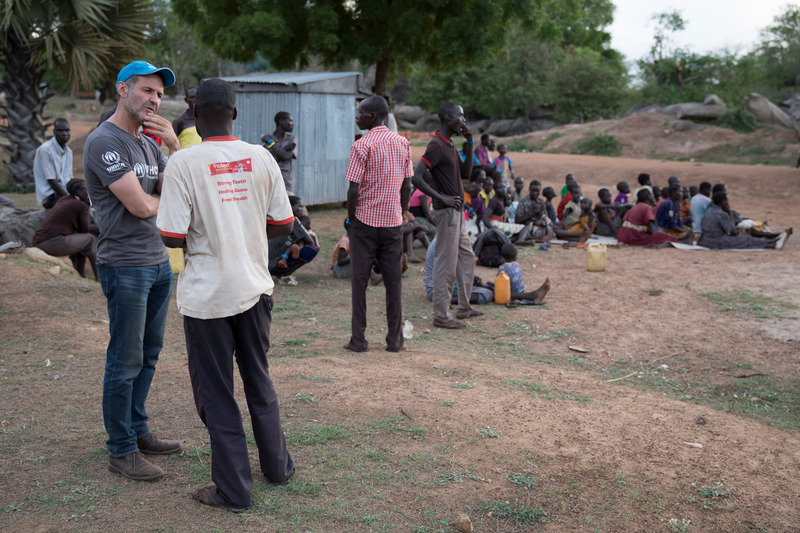
Khaled Hosseini, with refugees from South Sudan who have just crossed the border into Uganda.
They gather in shocked silence in a clearing by the ferry dock to wait for their crossing. One of the men tells me that soldiers opened fire on the streets of Pajok, in hospitals, in schools. People dropped everything and ran. Those who could not—the old, the infirm—were slaughtered. Families scattered into the bush, he says, the town emptied in hours. His family spent three days without food, living on wild roots, hiding in the bush and walking to the border. I look round me and see little in the way of belongings. Many here are barefoot. I pass a young mother breastfeeding, the infant only weeks old.
In the children spilling tiredly from these buses, I see the defining faces of the refugee crisis in South Sudan, Africa’s largest and fastest growing. Over 1.9 million refugees have fled into neighboring countries, over one million to Uganda. Most, 62 per cent, are children, frightened, confused, desperate for shelter and protection. I watch my colleagues interacting with the newly arrived refugees from Pajok, asking them questions, reassuring them that once they reach the reception centre, staff will help them with food, protection, water, shelter and medical care.
I admire the work being done here on the frontline of the crisis, even though, astonishingly, depressingly, UNHCR’s South Sudan emergency appeal is currently only 28 percent funded. I see in these busloads of refugees the urgent need for critical funds. Not the least because humanitarian organizations are supporting a refugee response model here in Uganda, that is ambitious and visionary and should not be allowed to fail.
This trip to Uganda differs from visits I have made to refugee operations in other countries. The most glaring difference here is the absence of fenced-off refugee camps. Rather, in remarkable acts of generosity and solidarity, individual and community land owners, as well as the government, donate land to the refugees. At the banks of the White Nile, as I watch the tired refugees from Pajok, I feel a little hope knowing that within a few days they will be allocated a plot of land on which to build their emergency shelter. They will be free to start cultivating crops there to become less reliant on aid.
Refugees in Uganda are allowed to move freely, to access the same healthcare and education systems as nationals, and they are allowed to work and own businesses. Uganda has its own painful history. It understands well that protracted war forces refugees to live in exile for years on average, often decades, and it has learned that all parties are best served when refugees are incorporated into national development plans, instead of being viewed strictly through a humanitarian lens. Uganda’s policy is not only progressive and compassionate, but also smart, as it helps better the lives of its own citizens.
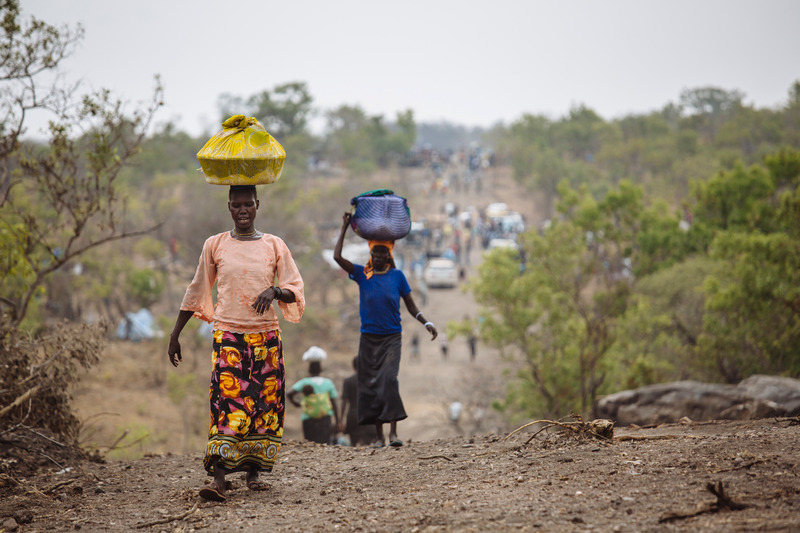
South Sudanese refugees walk down a road carrying their personal belongings in Bidibidi refugee settlement, Northern Region, Uganda.
Take the case of Bidibidi. A small village in north Uganda that, in just nine months, has grown into one of the world’s largest refugee settlements with over 272,000 inhabitants. Before the refugees arrived, there was no school here, no healthcare center, no graded roads. I sit under a tree with a local Ugandan farmer named Yahaya. He tells me that previously his youngest children weren’t receiving an education as the nearest primary school was a prohibitively long walk away. It used to take days to get his crops to market and back, he says, but with the new roads it now takes him a few hours.
Yahaya has donated land through the government scheme but also directly to refugees who have asked for extra land to cultivate. In this functional coexistence, made possible by Uganda’s refugee policy, I see the power of pragmatic generosity.
By the time we leave Bidibidi, I will have witnessed also the power of human generosity. Aisha has big, kind eyes, a slender frame. She is 29, an abandoned wife, and mother to two boys, aged 13 and 5. Last August, she fled South Sudan with her sons, a young niece and nephew. She tells me about a checkpoint stop, a soft tremble of indignation creeping into her voice, at which she was forced to kneel, her younger son in her clutch, the barrel of a gun pointed at her head. Death was a breath away. In the end, the soldiers took her money and belongings. Aisha and the children arrived in northern Uganda with next to nothing to call their own. They received a UNHCR emergency shelter and Aisha quickly went about building a more permanent home from mud bricks she made herself, and thatching a roof from grass that she collected from the bush, one bushel a day. It was hard work, she says, but she saw to it that the children were sheltered, fed, clothed, enrolled in school.
“You have come here to ensure the safety of your children, they are the hope and they are the future. It’s our wish that in your new home here you can make your children’s dreams and aspirations come true. Welcome to Uganda.”
When Aisha agreed to become a foster parent, the children were excited to have a new sibling to play with. But when Aisha met the foster child, she found that she was paralyzed on the right side of her body and doubly incontinent. She had been abandoned by her own mother. Aisha was told she could not feed herself or sit up or speak. She needed uninterrupted care and attention.
Aisha spent a night in prayer. In the morning, she knew. “I love her as my own now. But her condition is not easy,” Aisha says to me. “It is not easy for someone to accept her. But I cannot give up. Someone had to give her a home, give her somewhere safe to live.” She considered three names for the child: Gloria, Mercy, and Grace. She decided on Mercy, Aisha says, her fleeting smile an acknowledgment of the simple and poignant poetry of her choice.
“When can I go home and help my own people?” But if given the choice, grateful as she is to Uganda, Aisha would prefer to go home. Gladys told me the same thing. So does David, a former director of education in South Sudan, who now teaches refugee and Ugandan children in Nyumanzi Integrated Primary School. We are standing outside an empty classroom during his break time, talking about the school, when he pauses, his eyes going liquid. “Sometimes I wonder why God created me a refugee,” he says softly. “How long must I be a refugee? When can I go home and help my own people?”
Every refugee I have met—in Uganda, Chad, Jordan, Iraq, refugees from my own native Afghanistan—has echoed this wish. Nothing can replace the deep sense of connection with your birthplace. But when going back to your own country isn’t an option, home becomes the place where you feel a sense of belonging. A place where people don’t look at you and say, “You don’t belong here.” And there are too many voices of fear in the world right now telling refugees they are not wanted.
I think of a lovely moment that unfolds daily at the Koluba collection centre, where refugees are first brought for a hot meal and medical screening ahead of being allotted their land. Every morning, a representative from the Ugandan Office of the Prime Minister picks up a microphone and addresses them. Her smile is open. “You have come here to ensure the safety of your children,” she says. “They are the hope and they are the future. It’s our wish that in your new home here you can make your children’s dreams and aspirations come true. Welcome to Uganda.”
Donate now to help South Sudanese refugees like Aisha.

